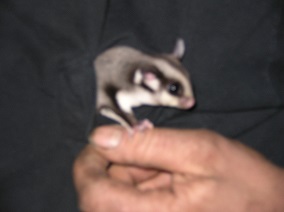sugarglider Babies
My sugarglider babies are sold between six and eight weeks of age.
Cage and Equipment Requirement
I believe large wire cages or large flight bird cages with a wire bottom make an excellent sugarglider cage. The type of cages with a deep plastic pan underneith the bottom are preferred to the wire cages with a shallow metal pan.
Accessories can include plastic chains,bird perches,pouches made of polar fleece or other materials to hide in that DO NOT have strings or fabric to get their nails caught on. A wheel is an excellent addition to any cage since most sugargliders love to run in a wheel. I highly suggest only using a solid plastic wheel. Little feet have a tendency to get caught in wire wheels.
Bedding
- ASPEN SHAVINGS are relatively safe bedding material but it is not very soft and it can be messy.
- PELLETED BEDDING is good to use,but if a sugarglider should eat some of the bedding the bedding could cause very serious problems such as intestinal blockages.(yesturday's news cats litter) non-scented is what I typically use.
- PINE SHAVINGS do not contain the harmful Plicatic Acid that cedar shavings have but they contain high levels of Abietic Acid when not heat cured which can cause similar problems after lenghty exposure. If using pine shavings make sure they are kiln dried.
- NEVER USE CEDAR SHAVINGS because they contain a toxin called Plicatic Acid and other aromatic (volatile) hydrocarbon or phenol compounds.NOTE ALL BEDDING SHOULD BE IN AN PAN UNDERNEATH THE CAGE so the gliders will not accidently eat.
Care
- Diet and nutrition Like many exotic animals, the Sugar Glider can suffer from calcium deficiencies if it is not fed an adequate diet. Calcium to phosphorus ratios should be 2:1 to prevent hypocalcemia sometimes known as hind leg paralysis (HLP).
In the wild, gliders live off gum and sap (typically from the eucalyptus), acacia trees, nectar and pollen, manna and honeydew and a wide variety of insects and arachnids. A captive glider's diet should be 50% insects (gut-loaded)or other source of protein(boiled chicken,boiled egg.etc., 25% fruit and 25% vegetables.
Some of the more recognized diets are BML, HPW, Priscilla Price Diet, and LBM. These diets are proper protein supplements for captive Sugar Gliders.
The Basic BML Mixture
1/2 Cup Honey, do not use honeycomb, raw or unfiltered honey. Most store bought honey is the one to use unless it uses one of the 3 words listed.
1 Egg (boiled or scrambled)
1/4 cup Apple Juice
Blend Well, turn off blender add next group of ingredients
1 4oz bottle Premixed Gerber juice with yogurt
1 teaspoon of Rep-Cal Herptivite vitamin suppliment.. I get this at Pet Smart..It has a blue label on a white plastic container.
Blend Well again, add next group of ingredients
2 teaspoons Rep-Cal Calicum Suppliment non-phosphorus with vitamin D3 .I get this at Pet Smart also..It has a pink label on it.
2 2 1/2 oz jar of Chicken baby food. The jar will either say Chicken with gravy or Chicken broth.
1/4 cup Wheat Germ
1/2 cup dry baby cereal
Blend well, turn off blender. Then you pour into a tupperware bowl or ice cube tray and freeze. This should feed one glider for about a month, feeding about 1 tablespoon per glider.
Do Not mix Fruits or veggies in before freezing
I feed them: 1 tablespoon of BML then I also give them 1 tablespoon fruits or 1 tablespoon veggies. (Example Monday, Wednesday and Friday they get fruits. Tuesday, Thursday, Saturday they get veggies.) We also feed them mealworms 8-10 per day of the small ones.
This is a great complete meal. There are other meals out there. The important thing to remember is whatever meal you feed..Don't substitute parts of one meal with another meal.
The use of dry food/pellets is a controversial topic. There are concerns it can cause abrasions in the mouth and throat of the glider and cause intestinal blockage however there are currently no published scientific studies that support either side of the topic.
- Keep your sugarglider out of drafts and in a warm location (preferably between 74°F and 80°F)
- sugargliders need fresh food and water every day, A variety of several good high quality foods are the best.
- Treats can include meal worms), hard-boiled egg, cooked scrambled egg, pinky mice(not very appealing),grasshoppers,crickets, and fresh fruits and vegetables, variety of baby foods, some sugargliders wont eat some treats given to them the first time they may need to be offered more than once before they accept a specific treat.
- I would highly reccomned a that you do as much research on sugargliders,and their diets,and their cages before purchasing one for a pet.
|




